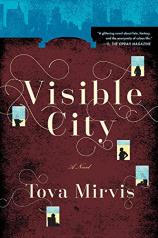Visible City
Review
Visible City
The Upper West Side residents who populate Tova Mirvis’s affecting third novel, VISIBLE CITY, boast enough advanced degrees to staff a small academic department, together with most of the outward markers of what passes for material success in America today. But whether it’s a marriage, a career or the stifling expectations of accomplished parents, each, in a different way, feels trapped in an emotional cul-de-sac. In this pensive story, Mirvis patiently untangles the complicated lives of these undeniably privileged characters to reveal some truths that aren’t unique to the intelligent, financially comfortable residents of one of this country’s more upscale neighborhoods.
Without exception, the lives of Mirvis’s characters are anything but what they appear to be. Nina, who has abandoned her legal career to care for her two small children, spends her evenings staring into the windows of the apartment across the street. There, she watches Leon, a psychologist who specializes in the treatment of anxiety disorders, and his wife Claudia, an art historian, pass their evenings in what she eventually understands is a shared isolation. Their daughter, Emma, temporarily lives with a mother and father she thinks of as “brains on a stick,” while she recovers from a broken ankle, chafing at the prospect of finishing her doctoral dissertation and marrying her novelist fiancé.
"In this pensive story, Mirvis patiently untangles the complicated lives of these undeniably privileged characters to reveal some truths that aren’t unique to the intelligent, financially comfortable residents of one of this country’s more upscale neighborhoods."
Instead of feeling like one of the “co-owners of a daycare center,” Nina, whose point of view is one of seven Mirvis adeptly balances, longs to “give in to the great gasp of desire, to the feeling of freedom unencumbered.” In what’s become something of a convention of literary fiction, her husband Jeremy, a midlevel associate in the real estate practice of a large law firm, likewise feels trapped between his crushing workload and the need to satisfy the insatiable demands of a monomaniacal partner who holds the young lawyer’s professional destiny in his hands. After an encounter on their street, Nina’s feelings draw her closer to Leon, a man nearly old enough to be her father, and someone who’s slowly coming to acknowledge the gulf that separates him from Claudia.
Each of these characters gropes in a different way toward a kind of self-knowledge. Leon recognizes he’s better at dispensing advice to his patients than he is at dispelling the emotional chill that’s the defining characteristic of his household. Claudia and Emma, in turn, slowly come to understand they’re responsible for their own happiness. Dealt with by a less capable writer, their stories, and those of the others, could have drifted off into the gauzy realm of self-help cliché, but Mirvis’s sure-handed grasp saves her from that flaw. Though all of these characters are drawn from the same demographic, she doesn’t lose sight of her responsibility to make each one's struggle singular and palpable.
But the novel’s focus isn’t strictly internal. Its main plot driver involves the construction of two luxury apartment buildings in the neighborhood by a client of Jeremy’s law firm. That project consumes most of his waking hours, but eventually offers him the chance, amid an encounter with a shadowy group whose activities involve exploring New York’s labyrinth of hidden places, to make a fateful choice, as he’s “reminded of something he was supposed to know: his life lay in his own hands.” Aside from what becomes this community flashpoint, Mirvis also has a well-honed eye and ear for the small bore tensions that boil over into controversies among neighbors anywhere, like the hostility between two dog owners, or a protest over a ban on noisy children in a popular local coffee shop.
Whether it’s Jeremy or Claudia encountering each other in the reading room of the New York Public Library, or Nina’s friend, Wendy, spying Nina and Leon in his car, there are times when Mirvis leans heavily on the mechanism of coincidence. One character reflects on the fact that even in a city the size of New York “there was no escape from the expanding web of intersections.” Armed with that insight, the interconnections between these characters eventually come to seem plausible, not artificial.
By the time she has knitted up all the delicate threads of her story, Mirvis reveals that freedom often involves the acceptance of responsibility, rather than simply casting off the fetters that bind us to daily life. Through Nina’s eyes, she offers a radiant vision of her characters’ newly discovered liberation and of the infinitely complex, extraordinary city in which that kind of reinvention can come to feel like a possibility every day.
Reviewed by Harvey Freedenberg on March 28, 2014
Visible City
- Publication Date: April 14, 2015
- Genres: Fiction
- Paperback: 256 pages
- Publisher: Mariner Books
- ISBN-10: 054448388X
- ISBN-13: 9780544483880





